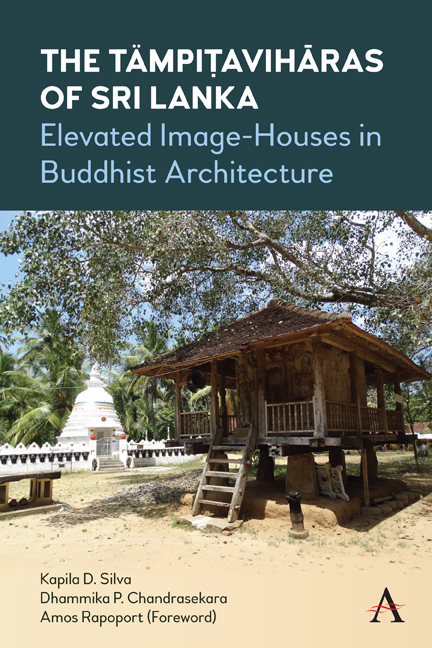Chapter 1 - The Tradition of Buddha Image-Houses in Sri Lanka
Published online by Cambridge University Press: 16 December 2021
Summary
The Concept of Image-house in Buddhist Architecture
Buildings found in Buddhist monasteries in Sri Lanka fall into a tripartite division – ritual, ecclesiastical, and residential – signifying the Buddha, the doctrine, and the monastic order, respectively (Bandaranayake 1974, 27). The three main ritualistic buildings – the stūpa, the bōdhi-tree shrine, and the image-house – essentially preserve the memory of the Buddha. The stūpa enshrines his bodily relics. The bōdhi tree (vruksha chētiya) is associated with his Enlightenment, and finally, the image-house, through anthropomorphic imagery, symbolizes the Buddha himself. From its very inception, Sri Lankan Buddhist monastic architecture focuses ritual-and-architectural attention on these three shrines.
The main purpose of these shrines is then to provide an opportunity for devotees to evoke the memory of their Master, experience his ‘living’ presence, pay respect to him, and draw spiritual inspiration from him. These shrines are neither designed for congregational worship (although they could accommodate many devotees) nor intended to mediate (through priestly intervention or mediation) between the devotee and the sacred presence. In keeping with the Buddhist doctrine, the informed devotional practice is purely between the individual devotee and the object of his/her devotion (Bandaranayake 1974, 138). Thus, in both ritualistic and architectural sense, these shrines essentially re-enact the memory of the Buddha, his virtues, and his spiritual motivations.
In this context, the image-house occupies a special position both on account of its ritualistic primacy and its utilitarian purpose by effectively reminding a devotee of the Master's presence. The stūpa and the bōdhi tree, though more sacred as per Buddhist scriptures, represent the Buddha in an indirect way, which does not immediately bring him to mind. As many Buddhist texts record, the Buddha's presence evoked amazement, awe, and a sense of devotion among lay believers: they tried to absorb a fraction of his sublimeness merely by gazing at him, and this resulted in ecstasy, worship, and endowing him with offerings (Silva 1988, 212). People ultimately desired to have an image-shrine that represented the Buddha and to pay reverence when he was away from the monastery. The Buddha did not grant this: the Enlightened One passes into a non-apprehensible state at the end of his life, never to be reborn, and in truth, no one would see him.
- Type
- Chapter
- Information
- The Tämpitaviharas of Sri LankaElevated Image-Houses in Buddhist Architecture, pp. 7 - 24Publisher: Anthem PressPrint publication year: 2021

